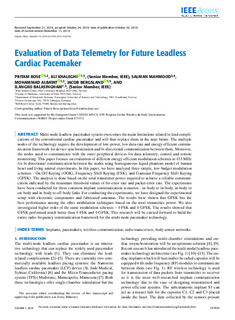| dc.contributor.author | Bose, Pritam | |
| dc.contributor.author | Khaleghi, Ali | |
| dc.contributor.author | Mahmood, Salman | |
| dc.contributor.author | Albatat, Mohammad | |
| dc.contributor.author | Bergsland, Jacob | |
| dc.contributor.author | Balasingham, Ilangko | |
| dc.date.accessioned | 2020-02-14T07:18:21Z | |
| dc.date.available | 2020-02-14T07:18:21Z | |
| dc.date.created | 2020-02-03T17:05:41Z | |
| dc.date.issued | 2019 | |
| dc.identifier.citation | IEEE Access. 2019, 7 157933-157945. | nb_NO |
| dc.identifier.issn | 2169-3536 | |
| dc.identifier.uri | http://hdl.handle.net/11250/2641651 | |
| dc.description.abstract | Multi-node leadless pacemaker system overcomes the main limitations related to lead complications of the conventional cardiac pacemaker and will thus replace them in the near future. The multiple nodes of the technology require the development of low-power, low data-rate and energy-efficient communication framework for device synchronization and bi-directional communication between them. Moreover, the nodes need to communicate with the outer peripheral devices for data telemetry, control and remote monitoring. This paper focuses on evaluation of different energy-efficient modulation schemes at 433 MHz for bi-directional communication between the nodes using homogeneous liquid phantom model of human heart and living animal experiments. In this paper, we have analyzed three simple, low-budget modulation schemes - On Off-Keying (OOK), Frequency Shift-Keying (FSK), and Gaussian Frequency Shift-Keying (GFSK). The analysis is done based on the total transmitter power required to achieve a reliable communication indicated by the minimum threshold values of bit-error rate and packet-error rate. The experiments have been conducted for three common implant communication scenarios - in-body to in-body, in-body to on-body and in-body to off-body links. For conducting the experiments, we have designed the experimental setup with electronic components and fabricated antennas. The results have shown that GFSK has the best performance among the other modulation techniques based on the total transmitter power. We also investigated higher order of the same modulation schemes - 4-FSK and 4-GFSK. The results showed that GFSK performed much better than 4-FSK and 4-GFSK. This research will be carried forward to build the entire radio frequency communication framework for the multi-node pacemaker technology. | nb_NO |
| dc.language.iso | eng | nb_NO |
| dc.publisher | Institute of Electrical and Electronics Engineers (IEEE) | nb_NO |
| dc.rights | Navngivelse 4.0 Internasjonal | * |
| dc.rights.uri | http://creativecommons.org/licenses/by/4.0/deed.no | * |
| dc.title | Evaluation of data telemetry for future leadless cardiac pacemaker | nb_NO |
| dc.type | Journal article | nb_NO |
| dc.type | Peer reviewed | nb_NO |
| dc.description.version | publishedVersion | nb_NO |
| dc.source.pagenumber | 157933-157945 | nb_NO |
| dc.source.volume | 7 | nb_NO |
| dc.source.journal | IEEE Access | nb_NO |
| dc.identifier.doi | 10.1109/ACCESS.2019.2950146 | |
| dc.identifier.cristin | 1790428 | |
| dc.description.localcode | Open Access CC-BY | nb_NO |
| cristin.unitcode | 194,63,35,0 | |
| cristin.unitname | Institutt for elektroniske systemer | |
| cristin.ispublished | true | |
| cristin.fulltext | original | |
| cristin.qualitycode | 1 | |

